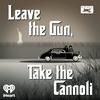Leave the Gun, Take the Cannoli: The Epic Story of the Making of the Godfather

11 episodes

The Grand Finale
2025-4-23 | 27 mins.
The cast of characters behind “The Godfather”’s success was nothing if not eclectic, from down-and-out Hollywood legends to ascendant show business superstars. Yet somehow, fifty years after its release—against all odds—the film remains in a league of its own for its evocation of the American dream, and for kickstarting a cultural fascination with the Mafia that endures today. On the tenth and final episode of “Leave the Gun, Take the Cannoli,” Mark and Nathan reflect on the lasting legacy of the movie, and how it impacted the lives of those like Evans, who considered the film his crowning achievement.See omnystudio.com/listener for privacy information.

The Mother of all Publicity Campaigns
2025-4-16 | 23 mins.
By 1972, “The Godfather” had become the movie of the moment—and that’s before it even hit theaters. Leading up to the film’s nationwide release that March, critics and made men alike clamored to get an early look, motivated in part by the tactful publicity strategy devised by Paramount’s Marilyn Stewart. To promote the film, she ensured that no photographs of Marlon Brando’s highly anticipated "transformation" into Don Vito Corleone leaked to the public. To see the Don, you’d have to buy a ticket. That’s not to say that audiences needed much convincing. In the wake of the movie’s New York City premiere—to which Robert Evans arrived with Ali MacGraw on one arm, and Henry Kissinger on the other—“The Godfather” was an immediate critical success, vindicating the strain Francis Ford Coppola endured to achieve his vision. On Episode Nine, Mark and Nathan reflect on "The Godfather"’s debut, and how its acclaim altered the lives of, among others, Coppola and Evans. In some ways, for the worse.See omnystudio.com/listener for privacy information.

Death by a Thousand Cuts
2025-4-09 | 25 mins.
It’s difficult to imagine “The Godfather’s” torrid Sicily scenes being filmed anywhere but Italy. Yet, if Paramount executives had gotten their way, Michael Corleone’s love affair with Apollonia—played by Simonetta Stefanelli, an unknown actress who spoke no English—would’ve transpired on a Los Angeles studio lot. Fortunately, things didn’t turn out that way. “The Godfather” decamped for Sicily in the summer of 1971, and no one was more pleased about this change of scenery than Francis Ford Coppola, who was finally able to distance himself from the overbearing Robert Evans and his spy Jack Ballard. Coppola’s respite wouldn’t last long, though. He returned to America with 90 hours of footage badly in need of editing. Naturally, Evans and his fellow bigwigs had opinions about that, too. In Episode Eight, Mark and Nathan follow Coppola and the cast and crew on their journey across the Atlantic and back again, discussing the director’s original three-hour cut of the film, Nino Rota’s iconic score that almost never was, and Evans’s tennis injury and subsequent drug addiction. See omnystudio.com/listener for privacy information.

Italians, Stallions, and Corporate Lackeys
2025-4-02 | 40 mins.
From a strict budget and a tight timetable to the interference of the Mafia, Francis Ford Coppola had more than enough on his plate directing “The Godfather”—and that was before his own studio turned against him. During the early days of filming, in 1971, Paramount disparaged Coppola’s decision making at every turn, both through disgruntled messages sent by Robert Evans and in the form of Jack Ballard, a Paramount executive who shadowed Coppola on-set with the express goal of scrutinizing his every move. And yet, Coppola’s hellish experience couldn’t have been more different from the cast’s. Beginning with an Italian-style dinner in New York on St. Patrick’s Day that year (which ended with James Caan mooning Marlon Brando from his car), “The Godfather’s” stars remained more or less happy throughout filming—an attitude aided heavily by the presence of Brando, whom the cast and crew idolized. In Episode Seven, Mark and Nathan explore the transition from the scripting process to filming, from Coppola’s production design philosophy and securing the infamous horse’s head to the moment Al Pacino first demonstrated his greatness.See omnystudio.com/listener for privacy information.

Married to the Mob
2025-3-26 | 20 mins.
Most big films confront roadblocks during production—financial, logistical, or otherwise. But how many Hollywood movies brush up against the Mafia, too? In 1970, the notorious crime boss Joseph Colombo founded the Italian-American Civil Rights League with the mission of dispelling stereotypes about his demographic, particularly those linking them to organized crime. Because of the Mafia’s depiction in Mario Puzo’s novel, the movie quickly became a prime target for Colombo and the League. Suddenly, the picture’s producers had trouble securing filming locations, the Teamsters Union threatened to freeze all transportation for the movie, and death threats were allegedly delivered to Robert Evans and Al Ruddy. In Episode Six, Mark and Nathan look back at Colombo’s role in turning Italian-Americans against The Godfather, and how Al Ruddy—after cutting a controversial deal, which led to a media firestorm and his firing and re-hiring—kept The Godfather from sleeping with the fishes. See omnystudio.com/listener for privacy information.
More Society & Culture podcasts
Trending Society & Culture podcasts
About Leave the Gun, Take the Cannoli: The Epic Story of the Making of the Godfather
Listen to Leave the Gun, Take the Cannoli: The Epic Story of the Making of the Godfather, The Telepathy Tapes and many other podcasts from around the world with the radio.net app

Get the free radio.net app
- Stations and podcasts to bookmark
- Stream via Wi-Fi or Bluetooth
- Supports Carplay & Android Auto
- Many other app features
Get the free radio.net app
- Stations and podcasts to bookmark
- Stream via Wi-Fi or Bluetooth
- Supports Carplay & Android Auto
- Many other app features


Leave the Gun, Take the Cannoli: The Epic Story of the Making of the Godfather
download the app,
start listening.




























